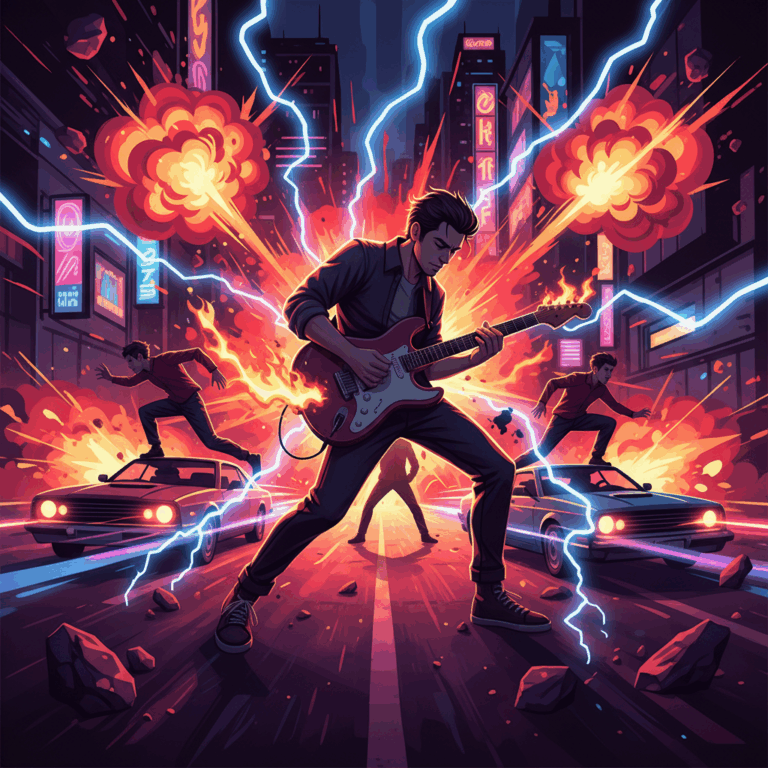Characteristics of action music
Action music is distinguished by its ability to transform ordinary scenes into moments charged with energy and tension. Its rhythmic structure is key to maintaining the viewer's attention.
This type of music uses sound elements that create an intense atmosphere, preparing the audience for what's to come in the narrative. Its design is intended to amplify the emotions present in each scene.
Rhythmic and percussive elements
Fast-paced rhythms and powerful percussion are hallmarks of action music. These elements set the pulse of chase or combat scenes, creating a constant sense of urgency.
The synthesized bass and prominent drums intensify the sonic experience, promoting a physiological response in the listener that results in increased adrenaline and concentration.
Rhythmic repetition and dynamic patterns keep the energy high, synchronizing the music with the visual rhythm of the action on screen to maximize emotional impact.
Musical genres and combinations
Action music fuses genres such as epic rock, dubstep, and orchestral music, combining classical instruments with modern technology to create unique atmospheres.
This mix allows the music to evoke feelings of chaos and tension appropriate for chases, conflicts, or unexpected discoveries during the plot.
The use of synthesizers alongside the orchestra provides sound textures that vary between organic and electronic, facilitating a versatile and powerful listening experience.
Emotional and physiological effects
Action music not only drives the visual narrative but also triggers physical responses in the body. Its energy activates the release of adrenaline, vital for intense and exciting scenes.
This phenomenon creates a direct connection between what is seen and what is felt, amplifying the viewer's emotions and keeping their focus on every crucial moment of the story.
Furthermore, its influence goes beyond simple accompaniment, acting as a stimulus that transforms perception and emotional experience during the action.
Adrenaline generation
Action music produces an immediate physiological response in the listener by stimulating the generation of adrenaline, preparing them to face situations of tension or danger.
This hormonal increase intensifies the perception of risk and speed, making combat or chase scenes feel more real and exciting for the audience.
Thus, adrenaline acts as a natural mechanism that amplifies immersion, aligning body and mind with the intensity of the music and the image.
Amplification of the emotional experience
Beyond the physical effect, action music amplifies the emotions present in each scene, enhancing feelings such as fear, urgency, or bravery.
Through sound combinations and increasing dynamics, this music allows the viewer to feel each plot twist more deeply and connect emotionally with the characters.
This amplification makes the sequences memorable, enhancing the emotional impact and audience satisfaction during key moments.
Impact on viewer attention
The action music directs and sustains the viewer's attention through intense rhythms and strategic auditory changes that maintain constant interest.
By synchronizing with the visual dynamics, it reinforces concentration and prevents the mind from wandering, ensuring that every detail of the scene is perceived and valued.
This auditory approach contributes to a more immersive and exciting experience, making the action the absolute center of the narrative.
Importance in film and pop culture
Action music becomes a narrative force that propels stories in film and pop culture, lending scenes dynamism and emotional depth. Its presence is essential to maximizing tension and visual impact.
In addition to providing accompaniment, the music acts as another character that influences the viewer's perception, establishing rhythms and moods that guide the sensory and emotional experience during the development of the plot.
Music as a narrative character
Action music doesn't just complement the visuals; it also tells a parallel story that enriches the visual narrative. It becomes an active element that drives emotions and foreshadows events.
With its variations in rhythm and tonality, the music accompanies the characters in their conflicts, reinforces key moments, and adds layers of meaning that transform the viewer's experience.
This approach turns the soundtrack into a narrative ally, essential for exploring the motivations and internal tensions that the images alone cannot fully express.
Examples in franchises and films
Major franchises like "Mission Impossible" use action music to create unique atmospheres that become iconic in cinema, with themes that immediately evoke feelings of urgency and adventure.
Movies like “Guardians of the Galaxy” stand out for their soundtrack, which blends action and nostalgia, demonstrating how music can elevate and define the identity of a production and its cultural reception.
These examples reflect how action music transcends background sound, becoming an integral part of the appeal and commercial success of many popular productions.
Iconic applications and examples
Classic action songs have transcended film to become universal symbols of motivation and energy. Their relevance remains strong thanks to their constant use in various media.
These compositions not only elevate scenes in movies, but have also found a special place in sporting events and video games, reinforcing the feeling of adrenaline and challenge.
Classic songs and their relevance
"Eye of the Tiger" by Survivor is an anthem that represents overcoming adversity and strength, adopted in numerous films and sporting competitions for its contagious energy.
Other songs, such as AC/DC's "Thunderstruck," have recognizable riffs that instantly motivate and prepare the audience for intense moments of action or competition.
These classic themes remain relevant thanks to their ability to evoke powerful emotions that connect the listener with the experience of action and extreme effort.
Use in digital entertainment and sports
In the digital world, action music enhances the video game experience, creating immersive atmospheres that occur during battles or important missions.
Furthermore, at sporting events, these songs are used to cheer on the audience and boost the energy of athletes, making each encounter more exciting and memorable.
A curious fact about musical integration
Many video games choose to produce original soundtracks with action music influences to perfectly synchronize the music with the game's dynamics.
This integration enhances the player's emotional response, intensifying every moment of tension thanks to the accompanying musical force.






